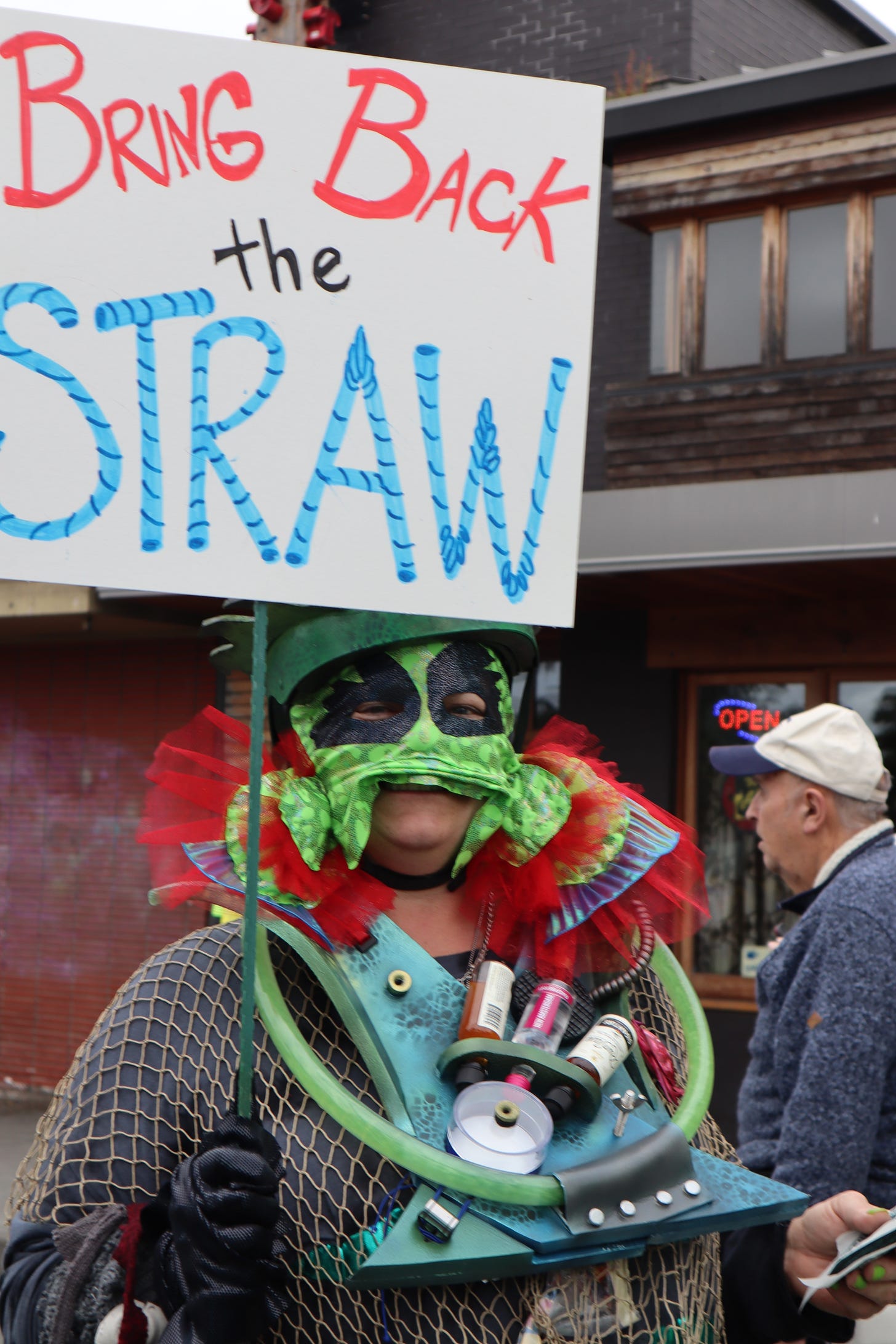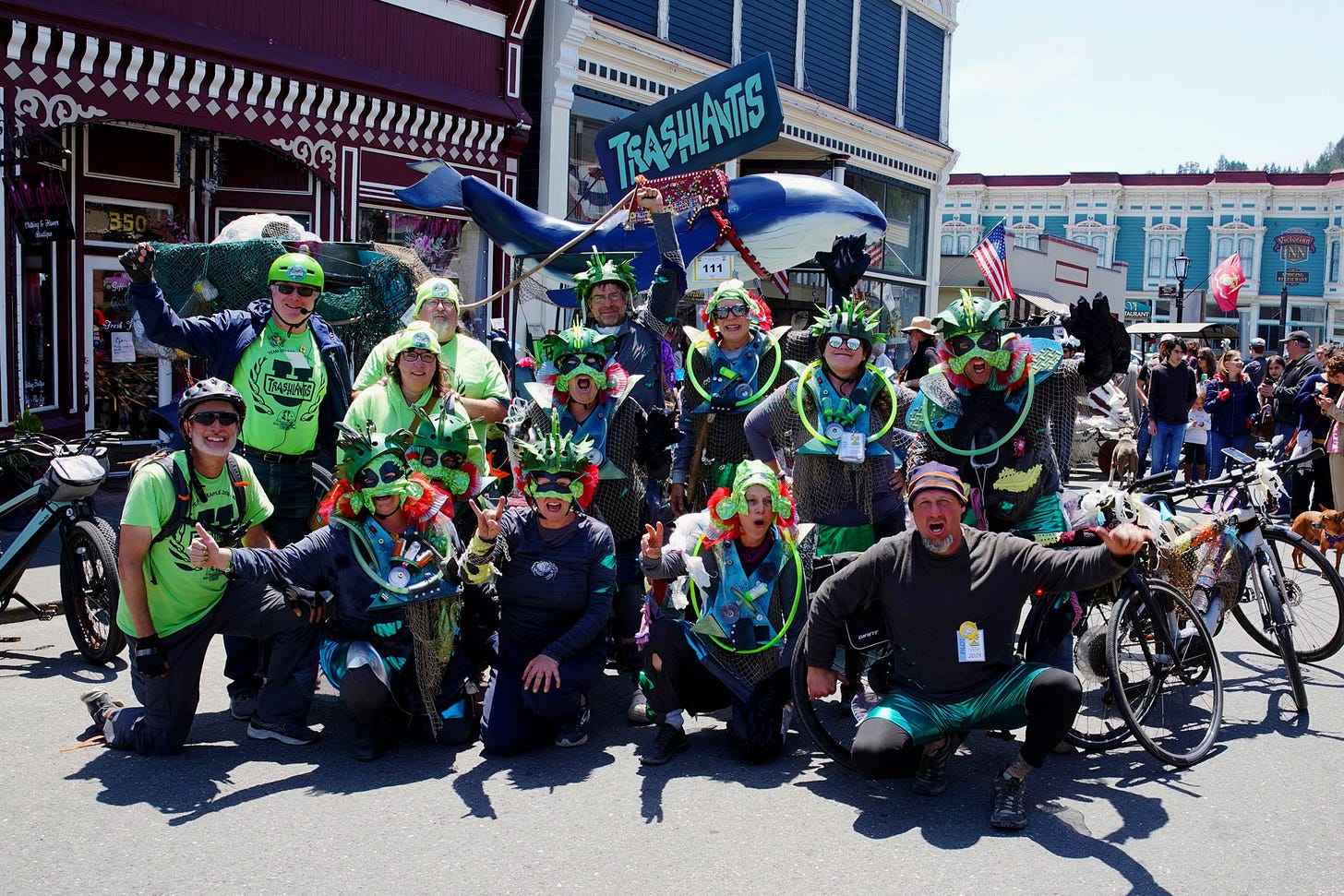Local art teachers win Kinetic Sculpture Race again with "Trashlantis"
Plastic-eating monsters parody our all-consuming need for all things plastic
by Dawn Thomas and Robert van de Walle
Sebastopol residents Dawn Thomas and Robert van de Walle were once again the winners of the Kinetic Grand Championship, a race which takes place on Memorial Day each year in Ferndale. Last year’s winning entry was featured in this article: “Team Pineapple Takes a Victory Lap.” Team Pineapple has a lot of fun but they also deliver a provocative message through their art—DD

“Gimme, gimme, gimme, gimme your trash, I want to eat your plastic!” sang the Trashlanteans, a red-gilled group of half-humans. Our team of artist-athletes danced and mugged for the Pageantry Judges of the Kinetic Grand Championship, an art and endurance race held every year in Humboldt County over Memorial Day weekend. We won last year, and were targeting a repeat victory. One performer crawled into a recycling bin searching for plastic. Another waved a sign demanding “bring back the straw.” The crowd sang along and the dance reached a joyous frenzy celebrating our species’ addiction to plastic.

The Kinetic Grand Championship originated in 1969 when Jack Mays challenged Hobart Brown to a sculpture race in Ferndale, California. Over time the race became longer and tougher. Teams must propel themselves over land, sand and water, without the use of stored energy, on homemade contraptions carrying all they need for the 3-day event, including toothbrushes and an “object of comfort no smaller than a coffee cup.” Points are awarded for engineering, art, speed and pageantry.

While many teams compete for the fun of it, we build sculptures designed to initiate a “difficult conversation” with the crowds of spectators. Race coverage propels our message into social media, photos and articles written about the Kinetic Grand Championship. In 2022, we built Humpbacks Of Notre Dame, set in the year 2069 after the oceans rise, to talk about anthropogenic climate change. The sculpture featured whales frolicking around a partially submerged Notre Dame cathedral. We asked children if they’d like to chip off a piece of “the last glacier on Earth,” a chunk of ice we carried for the entire length of the race.
This year’s difficult conversation is our addiction to all things plastic. Our theme is Trashlantis: #AddictedtoPlastic, an imagined civilization of gilled humanoids that evolved under the Great Pacific Garbage Patch to eat plastic. As plastic-eating monsters we hold a mirror up to our current global society.

Our planet is on track to reach peak plastic in the year 2050. During Covid, we increased our plastic consumption considerably, and we continue to consume more plastic than ever before. We partnered with the North Coast Environmental Center to turn plastic collected on their beach cleanups into art to carry on our sculpture. Spectators asked The NEC and Trashlanteans, “Where did you get these numbered flags?” and “How did you make water bottles into sea creatures?”

When plastic was introduced, in the 1950’s, it was touted as the material of the future. The oil executives knew that recycling was too costly and impractical, but marketed it aggressively during the 1970’s to ease the consumer’s conscience. “(they)...sold the public on an idea it knew wouldn't work — that the majority of plastic could be, and would be, recycled — all while making billions of dollars selling the world new plastic.” 1
Today, people clean and place un-recyclable plastics and foam into their blue bins in a bid to reduce waste going into the landfill. This is called Wish-Cycling, and actually increases a bin load’s prospect of going into the landfill, because it has been contaminated with unrecyclable plastics.
"If the public thinks that recycling is working, then they are not going to be as concerned about the environment," Larry Thomas, former president of the Society of the Plastics Industry, known today as the Plastics Industry Association and one of the industry's most powerful trade groups in Washington, D.C., told NPR.2

When the oil executives realized that electric cars would bring down their profit margin for gasoline sales, they turned their sights on plastic production, and re-invigorated their efforts to market recycling as a solution to single-use plastics. Oil companies launched massive greenwashing campaigns, to keep plastic consumption up.
One walk down the aisles of any grocery, Target, or Walmart will confirm that everything is made out of– and wrapped in– plastic. Microplastics flow in our waterways, soil and even our blood. Ocean microplastics collect and concentrate toxic “forever chemicals”, which are consumed by plankton and enter the food chain.

Trashlantis holds a mirror up to our collective plastic addiction, but with a touch of silliness. Our theme song is a Ramones’ parody “I want to eat your plastic.” We support efforts to bring Plastic Pollution Awareness to conversations everywhere and inspire action towards reducing plastic production. The oil industry got us #AddictedtoPlastic. Through actions such as ours we hope to end the addiction and restore the health of our planet.
For more information, and to see how you can get involved, visit us at
Dawn Thomas is a middle school art teacher, artist, and author of The Kinetic Kompendium, 50 Years of Kinetic Sculpture Racing. She lives in Sebastopol with her deaf cat and a yard full of plant babies. Her partner Robert van de Walle designs human powered contraptions, which they build together.
Note: All pictures used by permission of the photographers for promotion of kinetics. Commercial redistribution beyond one-time use for an article in the Sebastopol Times is not permitted.




